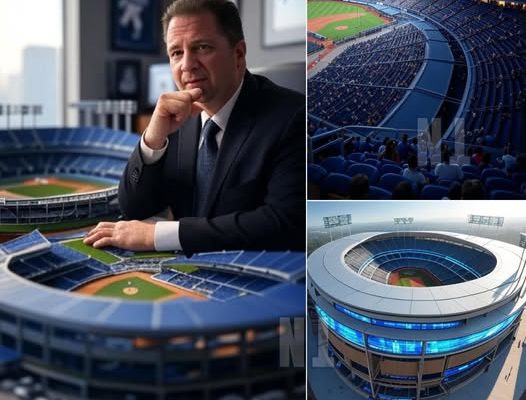BREAKING: Los Angeles Dodgers owner Mark Walter has unveiled one of the most ambitious sports infrastructure projects in modern history — a staggering $6.6 billion stadium renovation initiative that promises to redefine not just Dodger Stadium, but the entire concept of what a world-class fan experience entails. In an announcement that sent shockwaves through the world of sports and entertainment, Walter outlined a futuristic and fan-centric vision for the iconic stadium, emphasizing innovation, technology, accessibility, and cultural relevance. For a franchise that already possesses one of Major League Baseball’s most storied legacies, this bold undertaking signals a commitment to excellence that goes far beyond on-field performance.
The Los Angeles Dodgers are no strangers to evolution. Since their move to the West Coast from Brooklyn in 1958 and the opening of Dodger Stadium in 1962, the team has consistently sought to embody the values of innovation and adaptation. Yet even for a club with decades of forward momentum, the latest announcement feels unprecedented in scale and scope. Walter’s $6.6 billion vision is not merely a renovation; it’s a wholesale reimagining of the fan experience from the moment spectators enter the gates to the second they leave. Drawing comparisons to major entertainment hubs like Las Vegas’ Sphere and global sports cathedrals such as Tottenham Hotspur Stadium in London or SoFi Stadium in Inglewood, Walter’s vision pushes boundaries in every direction.
The renovation will transform Dodger Stadium into a fully immersive venue that incorporates augmented reality, artificial intelligence, and sustainable infrastructure. According to the initial design briefs released by the team, the stadium will feature a 360-degree wraparound halo screen — the largest of its kind in North American sports — that will allow fans in every section of the park to engage with live analytics, player statistics, social media integrations, and multilingual commentary. That screen alone is projected to cost over $300 million and will be constructed using environmentally friendly LED materials. The scoreboard will be customizable for various events, creating a flexible platform for concerts, World Baseball Classic games, and even esports tournaments.
Perhaps one of the most radical departures from traditional stadium architecture is the plan for multi-tiered skywalks and floating fan zones. These interconnected platforms will give spectators dynamic views of the game and the Los Angeles skyline, creating a sense of verticality and movement that defies the static, bowl-like structure of most baseball stadiums. Each fan zone will be themed — ranging from a vintage Brooklyn-inspired section with nods to Ebbets Field to a futuristic tech hub powered by 5G — providing fans with a choose-your-own-adventure style of spectating. These immersive experiences will also feature holographic player interviews, augmented-reality photo booths, and real-time fantasy baseball integration.
Accessibility will also take center stage. The renovation includes a restructured transportation grid around the stadium that connects to LA’s Metro system, making it easier than ever to reach Chavez Ravine without a car. Dedicated ride-share hubs, electric shuttle buses, and pedestrian sky bridges will significantly reduce congestion, a longtime issue for Dodger fans. In addition, more than $500 million will be allocated to ADA-compliant features, including sensory rooms, guided navigation for visually impaired guests, and multi-lingual signage throughout the stadium complex.
Walter emphasized that sustainability was non-negotiable in planning the renovation. The project is aiming for LEED Platinum certification, the highest standard in green building. Solar panel fields will be integrated into the upper deck canopies, producing enough electricity to power the stadium on game days. A new water recycling facility will be built onsite to maintain the stadium’s lush grass field and surrounding landscaping without drawing on the city’s municipal water supply. Furthermore, biodegradable concession packaging, smart waste bins, and composting stations will be placed throughout the facility in an effort to make Dodger Stadium the greenest sports venue in America.
Food and beverage experiences are also being completely overhauled. Dodger Dogs aren’t going anywhere, but they’ll be accompanied by a robust lineup of culinary offerings curated by Michelin-starred chefs and local LA food vendors. The renovation will see the construction of an open-air food market with rotating restaurant pop-ups, allowing fans to sample different cuisines from across LA’s diverse communities. In addition, a rooftop brewery will offer signature Dodger ales, with proceeds supporting youth baseball programs throughout Los Angeles County. Nutrition-conscious offerings will be front and center too, with plant-based options available at every concession stand and allergen-safe kitchens built into the infrastructure.
Luxury and hospitality are also getting a major upgrade. The stadium will now include a five-star hotel built into the outfield pavilion, with floor-to-ceiling windows that overlook center field. Hotel guests will have exclusive access to in-room live broadcast angles, luxury suites, and even postgame meet-and-greets with players. Other premium experiences will include infinity sky boxes, private field-level lounges, and ticket packages that include behind-the-scenes access to batting practice and locker room walkthroughs. These premium options are designed not just for wealthier fans, but for companies and influencers looking to integrate sports into their branding strategy.
Mark Walter spoke passionately about the project’s larger purpose during his announcement. “This renovation is about more than baseball,” he stated. “It’s about Los Angeles. It’s about what it means to gather in this city — a city of dreamers, creators, and risk-takers. We want to build something that reflects LA’s boldness, its diversity, and its imagination. We’re not just making a stadium for today. We’re building the venue of tomorrow.” Walter’s commitment to inclusion and community impact was underscored by a $250 million community investment initiative announced alongside the renovation. This fund will go toward expanding youth sports access in underserved communities, renovating public parks, and providing scholarships for sports-related academic fields like sports medicine, analytics, and journalism.
In addition, local labor unions and community organizers were consulted early in the planning process, ensuring that the project creates meaningful employment opportunities for LA residents. The Dodgers have pledged to prioritize union labor and small minority-owned contractors throughout the multi-phase construction process. An estimated 18,000 jobs will be created during the buildout, with long-term employment opportunities expected to follow once the expanded stadium opens its new restaurants, stores, and hospitality services.
As for the timeline, construction is set to begin at the conclusion of the 2025 season, with full completion targeted by Opening Day 2028. During this period, Dodger Stadium will remain operational with phased renovations scheduled around the baseball calendar. Fans can expect minimal disruption to the 2026 and 2027 seasons thanks to a flexible construction schedule coordinated in collaboration with the league and city officials. The team also plans to debut virtual tours and mobile apps that allow fans to track construction progress and learn more about each feature of the new stadium.
Reactions across the sports world were immediate and varied. MLB Commissioner Rob Manfred issued a statement applauding the Dodgers’ commitment to advancing the game. “Mark Walter and the Dodgers are pushing our sport into the future. This renovation will set a new bar for fan engagement, sustainability, and entertainment value,” Manfred said. Several Dodgers players, including Mookie Betts and Shohei Ohtani, took to social media to express their excitement. “Let’s goooo,” Betts wrote on Instagram, posting an artist’s rendering of the new clubhouse. “This is gonna be wild.” Meanwhile, fans flooded social media platforms with both praise and skepticism. While many celebrated the ambition and modern vision of the project, some long-time fans expressed concern over ticket prices and potential over-commercialization of the stadium’s nostalgic character.
Even so, the sheer magnitude and ambition of the project are hard to ignore. The $6.6 billion renovation dwarfs the cost of many recent stadium projects across professional sports. To put it into perspective, the construction of SoFi Stadium cost approximately $5.5 billion and became a global benchmark for multi-use sports venues. The Dodgers’ project is not just joining that echelon — it’s seeking to lead it. By integrating technology, sustainability, culture, and commerce into every level of planning, the franchise is staking a claim as the global leader in sports venue innovation.
Mark Walter’s vision, backed by bold investment and community-focused values, represents a paradigm shift in how we think about sports arenas. Dodger Stadium, already a sacred cathedral to baseball history, is poised to become something even more iconic: a futuristic temple of experience, a new mecca for sports and entertainment lovers, and a symbol of what the next generation of live events can and should look like. While the games will still be played on grass and dirt, everything surrounding that timeless competition is about to evolve — dramatically, ambitiously, and definitively. The Los Angeles Dodgers aren’t just planning for the next inning. They’re designing the next era.



